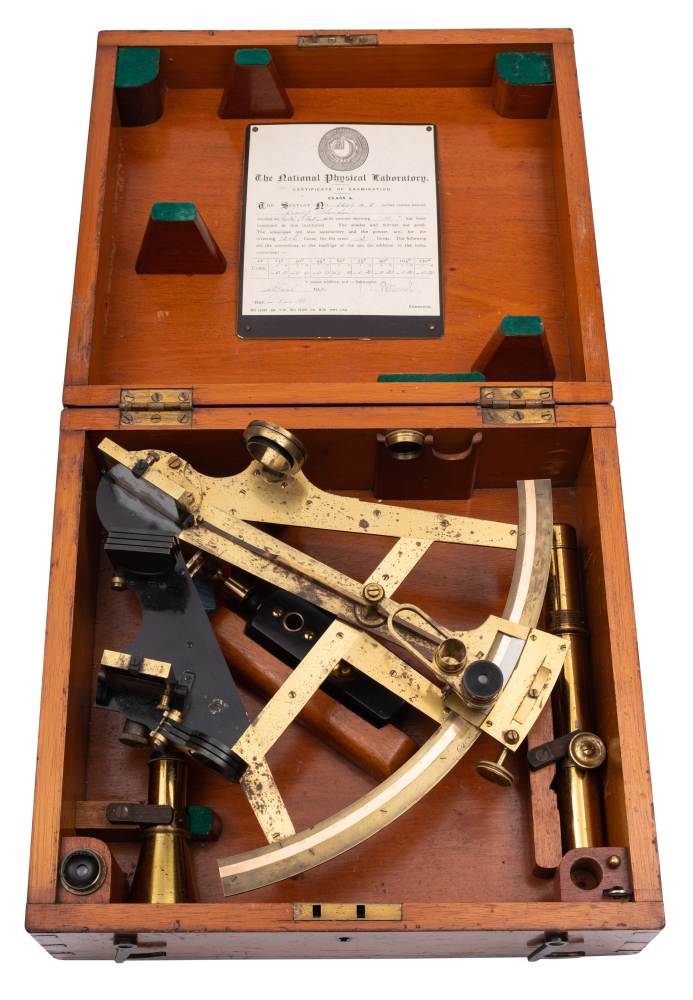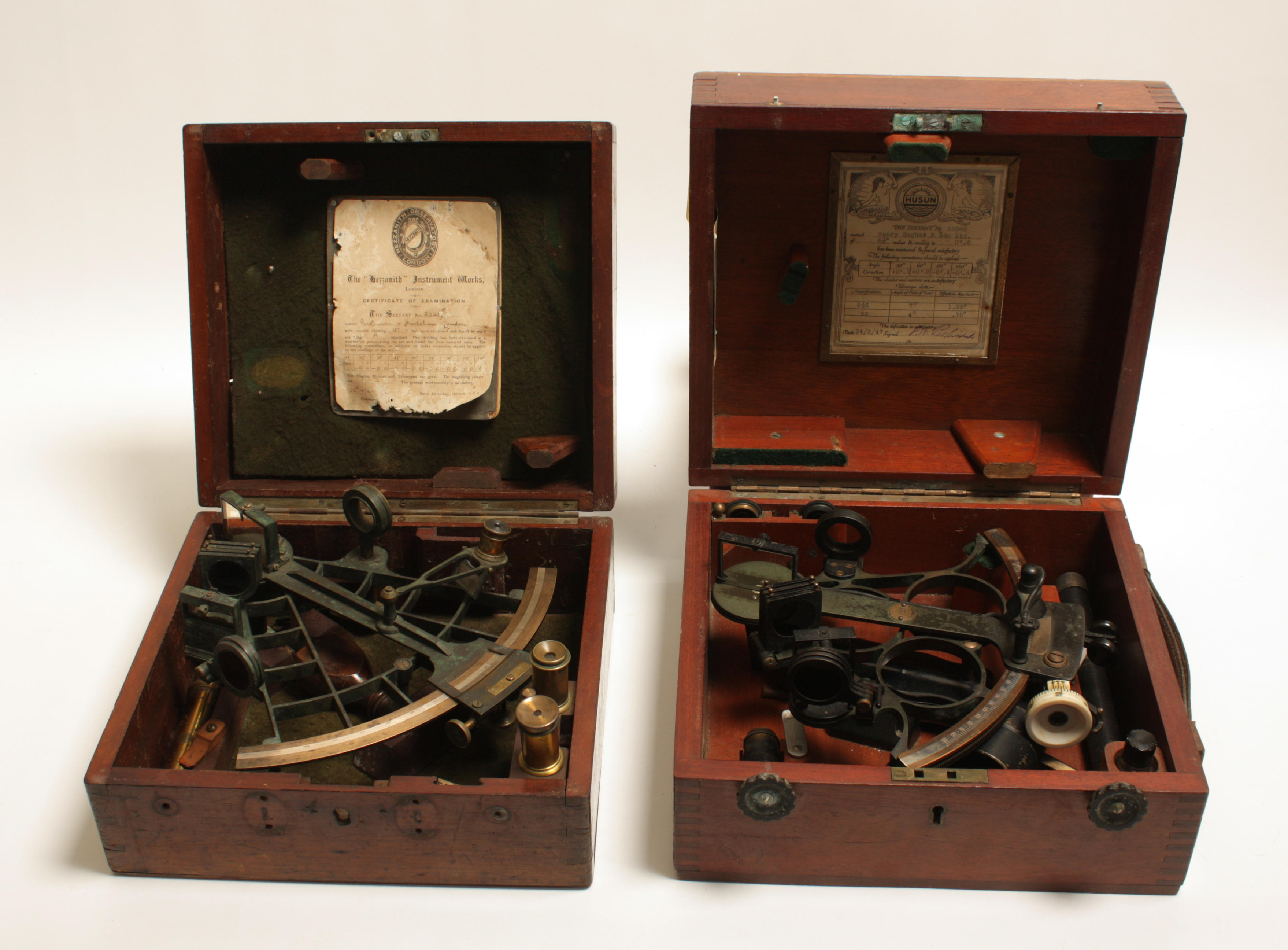19-inch Radius Mahogany Hadley's Quadrant or Octant by George Adams Senior, 1767 England, with bone plaque signed “G * Adams Mathl. Instt. Maker to his Majesty, Fleet Street, London. Saml. Clark, 1767", boxwood transversal scale calibrated 0–90° twice, index arm with brass fiducial edge and clamp, index glass, fore and back horizon glasses (with silvered and transparent optics) adjusted via rotating wing nuts and levers with milled clamps, two pinhole sights and a set of three shades, on three canted mahogany feet, radius 19 in. (48 cm). Good original condition. – A rare octant produced by royal instrument maker George Adams (c. 1709–1772) for the author and teacher of mathematics Samuel Clark (1738?–1784). Clark wrote and edited several technical works, including “The Young Mathematician's Guide" by John Ward, “The Complete Dictionary of Arts and Sciences, an Introduction to the Theory & Practice in Mechanics and the Mathematical Register" (1764) and “The British auger: or Trader's and Officer's Instructor" (1761). – In 1753 Adams printed a pamphlet on “The Description and Use of the Universal Trigonometrical Octant, Invented and Applied to the Hadley's Quadrant". A description of the development and nomenclature of the Hadley's quadrant (or octant) is to be found in Adams' “Geometrical and Graphical Essays, Containing a General Description of the Mathematical Instruments Used in Geometry, Civil and Military Surveying, Levelling and Perspective" published posthumously in 1803 (pp. 237 – 251). “It is thus that the discovery of the compass gave rise to the present art of navigation; and when this art grew of more importance to mankind, Divine Providence blessed them with the discovery of Hadley's quadrant, and in our own day and in our own time has further improved both it and the art of navigation, by which the present method of finding the longitude, which enables the mariner to ascertain with certainty his situation on the unvaried face of the ocean … It is an essential property of the instrument, derived from the laws of reflection, that half degrees on the arc answer to whole ones in the angles measured; hence an octant, or the eighth part of a circle, or 45 degrees on the arc, serves to measure 90 degrees; and sextants will measure an angular distance of 120 degrees, though the arc of the instrument is no more than 120 degrees. It is from this property that foreigners term that instrument an octant, which we usually call a quadrant, and which in effect it is. The property reduces indeed considerably the bulk of the instrument; but at the same time it calls for the utmost accuracy in the divisions, as every error in the arc is doubled in the observation. Another essential, and indeed invaluable, property of the instrument, whereby it is rendered particularly advantageous to marine observations, is, that it does not require any particular steadiness of the hand, nor is liable to be disturbed by the ship's motion; for, provided the mariner can see distinctly the two objects in the field of his instrument, no motion nor vacillation of the ship will hinder his observation. Thirdly, the errors to which it is liable are easily discovered, and readily rectified, while the application and use of it is facile and plain." References: Auction Team Breker, 24 May 2014, Lot 118 for a sea quadrant by George Adams (now in the collection of the Mariner's Museum and Park, Virginia). Großer Hadley’s Quadrant oder Oktant von George Adams Senior aus Mahagoni, 1767 England, Länge 48 cm, signierte Plakette aus Bein “G * Adams Mathl. Instt. Maker to his Majesty, Fleet Street, London. Saml. Clark, 1767", Skala aus Buchsbaum, zweimal kalibriert 0–90°, Index-Arm mit Ableseeinheit aus Messing und Klemme, in einen vertikal über den Alhidaden-Zapfen eingesetzter großer Indexspiegel, 2 Horizontgläser mit versilberter und transparenter Optik, auf der Unterseite mit Flügelmuttern und gefrästen Klemmen justiert, 2 Diopter-Visierein richtungen, 3 Blendgläs
19-inch Radius Mahogany Hadley's Quadrant or Octant by George Adams Senior, 1767 England, with bone plaque signed “G * Adams Mathl. Instt. Maker to his Majesty, Fleet Street, London. Saml. Clark, 1767", boxwood transversal scale calibrated 0–90° twice, index arm with brass fiducial edge and clamp, index glass, fore and back horizon glasses (with silvered and transparent optics) adjusted via rotating wing nuts and levers with milled clamps, two pinhole sights and a set of three shades, on three canted mahogany feet, radius 19 in. (48 cm). Good original condition. – A rare octant produced by royal instrument maker George Adams (c. 1709–1772) for the author and teacher of mathematics Samuel Clark (1738?–1784). Clark wrote and edited several technical works, including “The Young Mathematician's Guide" by John Ward, “The Complete Dictionary of Arts and Sciences, an Introduction to the Theory & Practice in Mechanics and the Mathematical Register" (1764) and “The British auger: or Trader's and Officer's Instructor" (1761). – In 1753 Adams printed a pamphlet on “The Description and Use of the Universal Trigonometrical Octant, Invented and Applied to the Hadley's Quadrant". A description of the development and nomenclature of the Hadley's quadrant (or octant) is to be found in Adams' “Geometrical and Graphical Essays, Containing a General Description of the Mathematical Instruments Used in Geometry, Civil and Military Surveying, Levelling and Perspective" published posthumously in 1803 (pp. 237 – 251). “It is thus that the discovery of the compass gave rise to the present art of navigation; and when this art grew of more importance to mankind, Divine Providence blessed them with the discovery of Hadley's quadrant, and in our own day and in our own time has further improved both it and the art of navigation, by which the present method of finding the longitude, which enables the mariner to ascertain with certainty his situation on the unvaried face of the ocean … It is an essential property of the instrument, derived from the laws of reflection, that half degrees on the arc answer to whole ones in the angles measured; hence an octant, or the eighth part of a circle, or 45 degrees on the arc, serves to measure 90 degrees; and sextants will measure an angular distance of 120 degrees, though the arc of the instrument is no more than 120 degrees. It is from this property that foreigners term that instrument an octant, which we usually call a quadrant, and which in effect it is. The property reduces indeed considerably the bulk of the instrument; but at the same time it calls for the utmost accuracy in the divisions, as every error in the arc is doubled in the observation. Another essential, and indeed invaluable, property of the instrument, whereby it is rendered particularly advantageous to marine observations, is, that it does not require any particular steadiness of the hand, nor is liable to be disturbed by the ship's motion; for, provided the mariner can see distinctly the two objects in the field of his instrument, no motion nor vacillation of the ship will hinder his observation. Thirdly, the errors to which it is liable are easily discovered, and readily rectified, while the application and use of it is facile and plain." References: Auction Team Breker, 24 May 2014, Lot 118 for a sea quadrant by George Adams (now in the collection of the Mariner's Museum and Park, Virginia). Großer Hadley’s Quadrant oder Oktant von George Adams Senior aus Mahagoni, 1767 England, Länge 48 cm, signierte Plakette aus Bein “G * Adams Mathl. Instt. Maker to his Majesty, Fleet Street, London. Saml. Clark, 1767", Skala aus Buchsbaum, zweimal kalibriert 0–90°, Index-Arm mit Ableseeinheit aus Messing und Klemme, in einen vertikal über den Alhidaden-Zapfen eingesetzter großer Indexspiegel, 2 Horizontgläser mit versilberter und transparenter Optik, auf der Unterseite mit Flügelmuttern und gefrästen Klemmen justiert, 2 Diopter-Visierein richtungen, 3 Blendgläs








Try LotSearch and its premium features for 7 days - without any costs!
Be notified automatically about new items in upcoming auctions.
Create an alert